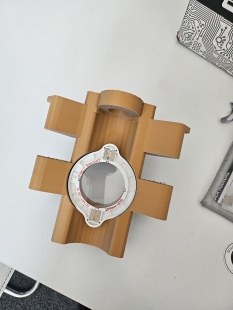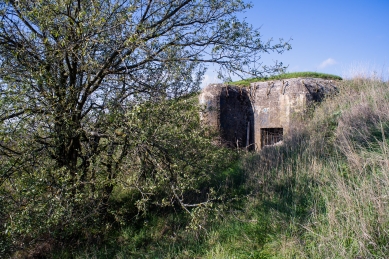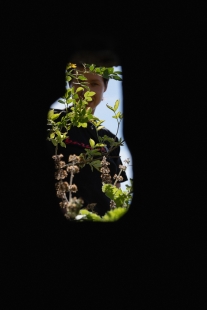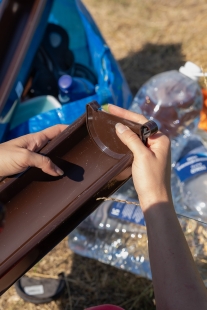
<tem>Obscure Cave</tem>
He sensitively explores the relationship between landscape, history, and light through the transformation of concrete bunkers – so-called Řopíks.
The project Obscure Cave by architect Karolína Burešová and photographer Franziska Nagelová is a sensitive exploration of the relationship between landscape, history, and light. The original design by Karolína Burešová was conceived as a concept for new uses of concrete structures of light fortifications – so-called Řopíky – with the aim of transforming their originally defensive function into a space for contemplation, slowing down, and perceiving nature as a changing living image. Řopíky, which were built in the 1930s in Czechoslovakia as part of the defensive system against the growing threat of Nazi Germany, were created under the direction of the Directorate of Fortification Works (ŘOP) along the borders and in the interior – often in hills, forests, and on plains – and were designed as resilient, mass-produced defensive points. In the area of today’s Šatov, several dozen of them were built, many of which have survived to this day.
The first phase of the project takes place in the form of an architectural installation in Šatov, where the Řopík is opened to the public as an observational object – a place where visitors enter silence, darkness, and slow time. The image of the landscape appears after an intervention of technology – only through natural light, material, and precise work with the architecture of the space. A place that once served for control and defense thus becomes a quiet space for observation, slowing down, and perception.
The second phase was developed in collaboration with photographer Franziska Nagelová and focused on recording these images using analog photography. Thanks to the principle of camera obscura, the interior of the bunker transforms into a darkroom. The image of the landscape thus becomes not just a metaphor, but a direct imprint of time and light. In three different seasons – in summer, autumn, and winter of 2024 – the authors captured images projected inside the bunker, experimenting with exposure times, directions of view, and chemical processes. The result is a series of unique photographs that resemble cave paintings – abstracted imprints of light and time created with the help of ancient optical principles.
The Obscure Cave oscillates between technology and visual experiment. It is a testimony to a landscape that deserves to be seen and perceived differently – not as an area for protection or exploitation, but as an organic whole, whose variability and beauty becomes a painting in itself. The project thus opens not only a space for contemplation but also a question: How does our relationship to the landscape change if we do not view it through the optics of control, but through an image? And at the same time – how does the meaning and value of architectural structures, originally intended for defense and war, transform when we give them a new role – to slow down, perceive light and the surrounding landscape as common heritage?
Řopíky, once a symbol of isolation and defense, become places of sharing and understanding within this project. The installation not only recalls the historical function of these objects but also offers a different perspective – a view inside, towards light and landscape. Through the camera obscura, the landscape, once perceived as a boundary, reappears as what connects us – as a living organism that deserves attention, care, and a new way of reading.
Can architecture of war, then, be transformed into an instrument of poetry, silence, and community?
The project was developed in collaboration with the Faculty of Architecture of VUT, the Technical Museum in Brno, TIC Retz, and the municipality of Šatov.
The first phase of the project takes place in the form of an architectural installation in Šatov, where the Řopík is opened to the public as an observational object – a place where visitors enter silence, darkness, and slow time. The image of the landscape appears after an intervention of technology – only through natural light, material, and precise work with the architecture of the space. A place that once served for control and defense thus becomes a quiet space for observation, slowing down, and perception.
The second phase was developed in collaboration with photographer Franziska Nagelová and focused on recording these images using analog photography. Thanks to the principle of camera obscura, the interior of the bunker transforms into a darkroom. The image of the landscape thus becomes not just a metaphor, but a direct imprint of time and light. In three different seasons – in summer, autumn, and winter of 2024 – the authors captured images projected inside the bunker, experimenting with exposure times, directions of view, and chemical processes. The result is a series of unique photographs that resemble cave paintings – abstracted imprints of light and time created with the help of ancient optical principles.
The Obscure Cave oscillates between technology and visual experiment. It is a testimony to a landscape that deserves to be seen and perceived differently – not as an area for protection or exploitation, but as an organic whole, whose variability and beauty becomes a painting in itself. The project thus opens not only a space for contemplation but also a question: How does our relationship to the landscape change if we do not view it through the optics of control, but through an image? And at the same time – how does the meaning and value of architectural structures, originally intended for defense and war, transform when we give them a new role – to slow down, perceive light and the surrounding landscape as common heritage?
Řopíky, once a symbol of isolation and defense, become places of sharing and understanding within this project. The installation not only recalls the historical function of these objects but also offers a different perspective – a view inside, towards light and landscape. Through the camera obscura, the landscape, once perceived as a boundary, reappears as what connects us – as a living organism that deserves attention, care, and a new way of reading.
Can architecture of war, then, be transformed into an instrument of poetry, silence, and community?
The project was developed in collaboration with the Faculty of Architecture of VUT, the Technical Museum in Brno, TIC Retz, and the municipality of Šatov.
The English translation is powered by AI tool. Switch to Czech to view the original text source.








0 comments
add comment









